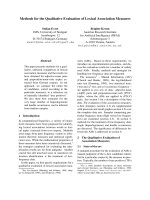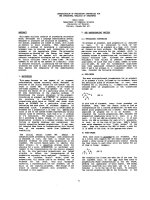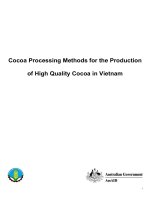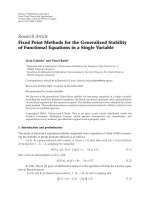Development of NMR methods for the structural elucidation of large proteins
Bạn đang xem bản rút gọn của tài liệu. Xem và tải ngay bản đầy đủ của tài liệu tại đây (9.68 MB, 257 trang )
DEVELOPMENT OF NMR METHODS FOR
THE STRUCTURAL ELUCIDATION OF
LARGE PROTEINS
ZHENG YU
NATIONAL UNIVERSITY OF SINGAPORE
2010
DEVELOPMENT OF NMR METHODS FOR
THE STRUCTURAL ELUCIDATION OF
LARGE PROTEINS
ZHENG YU
(B.Sc., Xiamen University)
A THESIS SUBMITTED
FOR THE DEGREE OF DOCTOR OF PHILOSOPHY
DEPARTMENT OF BIOLOGICAL SCIENCES
NATIONAL UNIVERSITY OF SINGAPORE
2010
Development of NMR methods for the structural elucidation of large proteins
Acknowledgements
i
Acknowledgements
I would like to express my sincere appreciation and gratitude to my enthusiastic
supervisor Associate Professor Yang Daiwen, for his guidance, inspiration,
patience, encouragement and trust throughout the project.
My special thanks to Prof. Ho, Chien from Department of Biological Sciences,
Carnegie Mellon University for providing the HbCO A sample and Prof. Wyss,
Daniel F. from Schering-Plough Research Institute for providing the AcpS
sample. Without their kind support and efficient collaboration it would not have
been possible for me to complete this project.
I would also like to express my appreciation to Dr. Mok, Yu-Keung and other
QE committee members, for their helpful advice and critical suggestions. Thanks
were also due to Dr. Xu, Yingqi and Dr. Fang, Jingsong for their assistance in
NMR experiments and data analysis.
I wish to take this opportunity to express my gratitude to my fellow graduates,
postdoctoral fellows, friends, brothers and sisters from department of biological
sciences and other departments/institutes. Their friendship made my research life
at the NUS a pleasant learning experience. In particular, I’d like to thank Lin Zhi,
Li Kai, Dr. Ru Mingbo, Shi Jiahai, Siu Xiaogang, Xu Xingfu, Yang Shuai, Dr.
Zhang Xu, Dr. Zhang Yonghong, and Zhang Yuning for many discussions and
help on the subject of this thesis.
Although any words are not even enough to express my heartfelt gratitude to my
family in China, I would still like to thank my parents for their sustaining family
Development of NMR methods for the structural elucidation of large proteins
Acknowledgements
ii
love and support. Without this everlasting love, I would not have been able to
accomplish or even start this thesis.
Lastly, the financial assistance in the form of a research scholarship provided by
National University of Singapore is gratefully acknowledged.
Development of NMR methods for the structural elucidation of large proteins
Table of Contents
iii
TableofContents
Acknowledgements
i
Table of Contents
iii
Summary
ix
List of Tables
xii
List of Figures
xiii
List of Abbreviations
xx
Chapter 1:
Related background and previous work
1
1.1 Protein NMR in structural biology
2
1.2 Protein structure determination by NMR spectroscopy
5
1.2.1 Protein sample preparation
7
1.2.2 NMR data Processing
7
1.2.3 Sequence-specific NMR resonance assignment
8
1.2.4 Structural restraint extraction
9
1.2.5 Structure calculation and refinement
9
1.3 Introduction to sequence-specific NMR resonance assignment
10
1.3.1 Important role of sequence-specific resonance assignment
10
1.3.2 General strategy for sequence-specific resonance assignment
13
1.3.2.1
1
H homonuclear assignment strategy
14
1.3.2.2 Triple-resonance assignment strategy
16
1.3.3 Limitations of the conventional strategies
20
1.4 Previous works on large proteins
21
1.4.1 Reducing protein transverse relaxation rate
23
Development of NMR methods for the structural elucidation of large proteins
Table of Contents
iv
1.4.2 Reducing protein spectral crowding and chemical shift
degeneration
25
1.5 Research objectives
26
Chapter 2:
Sequence-specific assignments of methyl groups in large proteins
28
2.1 Introduction
29
2.2 General strategy for sequence-specific assignments of methyl
groups
30
2.3 Discussion
35
2.4 Conclusion
38
2.5 Materials and methods
38
Chapter 3:
Side-chain assignments of methyl-containing residues in large proteins
40
3.1 Introduction
41
3.2 General strategy for side-chain assignments of methyl-containing
residues
44
3.2.1 Methyl assignments
44
3.2.2 Assignment of side-chain protons in methyl-containing
residues
47
3.3 Conclusion
51
3.4 Materials and methods
51
3.4.1 MQ-(H)CCH-TOCSY experiment
51
3.4.2 H(C)C
m
H
m
-TOCSY experiment
53
3.4.3 Protein Samples and NMR Spectroscopy
53
3.4.4 Correction of
13
C chemical shifts
54
Chapter 4:
A new strategy for structure determination of large proteins in
solution without deuteration
56
4.1 Introduction
57
Development of NMR methods for the structural elucidation of large proteins
Table of Contents
v
4.2 General strategy for sequence-specific assignments
58
4.2.1 General strategy for sequential assignment
58
4.2.1.1 Peak clusters
60
4.2.1.2 Spin-system identification and amino acid type
determination
64
4.2.1.3 Assembly and mapping of connectivity fragments
68
4.2.1.4 Resolution of ambiguity in connectivity
69
4.2.2 Side-chain assignment
72
4.3 NOE assignment and structure determination
72
4.4 Discussion and conclusion
79
4.5 Materials and methods
81
4.5.1 Protein samples and NMR Spectroscopy
81
4.5.2 Identifying spin-systems
82
4.5.3 Structure calculation
83
4.5.4 Data deposition
84
Chapter 5:
STARS: software for statistics on inter-atomic distances and torsion
angles in protein secondary structures
102
5.1 Introduction
103
5.2 Overview of STARS
104
5.2.1 Composition of database
104
5.2.2 Definition
105
5.2.3 User interface
111
5.3 Results and discussion
113
Chapter 6:
NMRspy: software package for NMR spectroscopy visualization,
analysis and management
114
6.1 Introduction 115
Development of NMR methods for the structural elucidation of large proteins
Table of Contents
vi
6.2 Feature and advantages of NMRspy
117
6.2.1 Intrinsic capabilities
117
6.2.2 Capability of analyzing Folded-spectrum
118
6.2.2.1 Proper frequency display of aliased peaks
118
6.2.2.2 Spectra synchronization & cursor correlation
120
6.2.3 Multi-dimension-peakpicking capability
123
6.2.4 Project management capability
125
6.2.5 Spectral view simplification capability
126
6.3 User’s interface
129
6.3.1 Control panel
130
6.3.1.1 Spectrum menu
132
6.3.1.2 DataSet menu
134
6.3.1.3 Project menu
134
6.3.1.4 Analysis menu
135
6.3.1.5 Extensions menu
138
6.3.2 Spectral display windows
139
6.3.2.1 Spectrum control bar
140
6.3.2.2 Mouse and keypad navigation
144
6.3.2.3 Status bar
146
6.3.3 Spectral attribute windows
147
6.3.3.1 File panel
148
6.3.3.2 View panel
150
6.3.3.3 Level panel
152
6.3.3.4 Peak & label panel
153
6.3.4 Other dialogs & windows 156
Development of NMR methods for the structural elucidation of large proteins
Table of Contents
vii
6.3.4.1 Peak (label, grid) editor 156
6.3.4.2 Peak (label, grid) table
157
6.3.4.3 Peak auto-assign dialog
158
6.3.4.4 Peak identification dialog
159
6.4 Results and discussion
160
Chapter 7:
XYZ4D: software plug-in for backbone assignment using the new
NOESY-based strategy
162
7.1 Introduction
163
7.2 Interface and algorithms
166
7.2.1 The main application window
166
7.2.2 Project preparation module
168
7.2.3 Spectral calibration module
171
7.2.3.1 Main panel
172
7.2.3.2 Selection of isolated HSQC peaks
173
7.2.3.3 HNCA calibration (H, N)
174
7.2.3.4 HN(CO)CA calibration (H, N)
176
7.2.3.5 HN(CO)CA calibration (C) 176
7.2.3.6 4DNOE calibration (H, N)
177
7.2.3.7 4DNOE calibration (C)
178
7.2.3.8 CCH diagonal calibration (C, CH)
180
7.2.3.9 CCH calibration (H,C)
181
7.2.3.10 Results panel
183
7.2.4 Cluster identification module
184
7.2.4.1 Method
185
7.2.4.2 Main panel 188
Development of NMR methods for the structural elucidation of large proteins
Table of Contents
viii
7.2.4.3 Cluster inspection panel
189
7.2.4.4 Results panel
192
7.2.5 CCH & 4DNOE inspection module
193
7.2.5.1 Interface
194
7.2.5.2 CCH water-peak elimination
196
7.2.5.3 CCH artificial -peak elimination
197
7.2.5.4 NOE-peak collection
198
7.2.5.5 NOE-peak alias correction
198
7.2.6 Spin-system identification module
199
7.2.6.1 Methods
200
7.2.6.2 Interface
202
7.2.7 Cluster mapping module
205
7.2.7.1 Methods
206
7.2.7.2 Interface
214
7.2.8 Backbone assignment module
220
7.3 Results and discussion
221
References
223
Publications
234
Development of NMR methods for the structural elucidation of large proteins
Summary
ix
Summary
Protein structures are an important source of information for understanding
biological function at the molecular level and provide the basis for many studies
in research areas such as structure-based drug design and homology modelling.
Currently the two main techniques for determining the three-dimensional
structures of biological macromolecules are X-ray diffraction and NMR
spectroscopy. In cases where proteins cannot be crystallized, NMR is the best,
perhaps the only, method available to characterize the structures.
At present, ~15% of protein structures deposited in the protein data bank is
determined by NMR, but only ~1% of the NMR structures are for proteins larger
than 25 kDa. Additionally, most of the large proteins only have crude global
folds based on backbone assignments and a few side chain assignments which
are obtained using deuterated samples. Unfortuantely, the preparation of
deuterated or/and specific isotopic labelled protein samples is often challenging
and places a bottleneck on the NMR study of large proteins.
In this thesis, I proposed several new NMR techniques and computational
methods to obtain partial or complete sequence specific assignments and to
further determine high-resolution structures of lager proteins, using both the
simple and cheap non-deuterated protein samples.
Firstly, a new 3D multiple-quantum MQ-(H)CCmHm-TOCSY
experiment is presented in chapter 2 to assign methyl resonances in high-
molecular weight proteins, on the basis of spectral patterns and prior backbone
assignments. The favorable relaxation properties of the multiple-quantum
Development of NMR methods for the structural elucidation of large proteins
Summary
x
coherences and the slow decays of in-phase methyl
13
C magnetizations optimize
performance of the proposed experiment for application to large proteins. In
combination with the H(C)CmHm-TOCSY experiment, a strategy is presented in
chapter 3 for assigning protons of methyl-containing residues of uniformly
13
C-
labeled large proteins.
Secondary, I present a novel strategy in chapter 4 to assign backbone and
side chain resonances of large proteins without deuteration, with which one can
obtain high resolution structures from
1
H-
1
H distance restraints. The strategy
uses information from through-bond correlation experiments to filter intra-
residue and sequential correlations from through-space correlation experiments,
and then matches the filtered correlations to obtain sequential assignment. The
strategy extends the size limit for structure determination by NMR to 42 kDa for
monomeric proteins and to 65 kDa for differentially labeled multimeric proteins
without deuteration or selective labeling.
To assist the development of the new strategy mentioned above, a graphics
package STARS was developed for performing statistics on interatomic distances
and torsion angles in protein secondary structures from a protein crystal structure
database. This graphics package shown in chapter 5 is also capable of facilitating
assignment of ambiguous NOESY peaks, NMR structure determination, structure
validation and comparison of protein folds.
In order to comply with the requirements of our new experiments and
strategies, I present a new software package NMRspy in chapter 6 which can be
used for NMR spectroscopy visualization, analysis and management. It provides
a variety of function and analysis routines that facilitate the analysis of complex,
Development of NMR methods for the structural elucidation of large proteins
Summary
xi
crowded and folded high-dimensional spectra. On the basis of this software
platform, in chapter 7 I present a software extension XYZ4D for semi-automatic
and automatic analysis of NMR data using the novel strategy shown in chapter 4.
This software extension corresponds to the manual assignment steps of the new
strategy but release users from tedious and time-consuming routines.
Development of NMR methods for the structural elucidation of large proteins
List of Tables
xii
ListofTables
Table 1.1:
Heteronuclear Experiments Used for protein sequence-
specific resonance assignment.
17
Table 2.1:
The relatively good dispersion of (
13
C
α
,
13
C
β
) chemical
shifts in large monomeric proteins.
35
Table 3.1:
Summary of assignment of non-methyl protons in
methyl-containing residues of both α- and β-chains of
rHbCOA.
49
Table 4.1:
Summary of clusters, spin-systems, dipeptide segments
and assignments.
63
Table 4.2:
Structural statistics for the final 10 conformers of MBP. 75
Table 4.3:
Structural statistics for the final 10 conformers of HbCO
A.
76
Table 4.4:
Experimental parameters. 77
Table 5.1:
Ten types of secondary structures defined in STARTS
and their one-letter symbols.
106
Table 6.1:
Icons in control bar. 140
Table 7.1:
Statistic
13
C-
1
H chemical shift region. 199
Development of NMR methods for the structural elucidation of large proteins
List of Figures
xiii
ListofFigures
Figure 1.1:
The flowchart of protein structure determination by NMR. 6
Figure 1.2:
Schematic depiction of backbone assignment using the
CBCANH and CBCA(CO)NH spectra.
18
Figure 1.3:
Effects of protein size on NMR signals. 22
Figure 2.1:
Pulse sequence for the MQ-(H)CC
mHm-TOCSY experiment. 31
Figure 2.2:
Representative slices from the MQ-(H)CC
mHm-TOCSY
spectrum used for methyl assignments.
33
Figure 2.3:
CT
13
C-
1
H HSQC of the
13
C,
15
N-labeled AcpS. Cross-peaks
are labeled with their assignments.
34
Figure 2.4:
Histograms of signal-to-noise ratios of correlations from MQ-
(H)CC
m
H
m
-TOCSY and HCCH-TOCSY spectra acquired at
25 ºC.
37
Figure 2.5:
Pulse scheme for the CC
m
H
m
-TOCSY experiment applied to
2
H,
13
C,
1
H
m
-labeled protein samples.
39
Figure 3.1:
Representative F1–F3 slices from the MQ-(H)CC
m
H
m
-
TOCSY (A) and MQ-(H)CCH-TOCSY (B) spectra of
13
C-
labeled α-chain of rHbCO A.
43
Figure 3.2:
CT
13
C-
1
H HSQC of the
13
C-labeled α-chain and β-chain of
rHbCO A.
46
Figure 3.3:
Representative F1–F3 slices from the H(C)C
m
H
m
-TOCSY
spectrum of
13
C-labeled β-chain of rHbCOA.
48
Development of NMR methods for the structural elucidation of large proteins
List of Figures
xiv
Figure 3.4:
F1-F3 slices taken from the spectra of H(C)C
m
H
m
-TOCSY,
MQ-(H)CC
m
H
m
-TOCSY and MQ-(H)CCH-TOCSY
experiments.
50
Figure 3.5:
Pulse sequences for the MQ-(H)CCH-TOCSY (A) and
H(C)C
m
H
m
-TOCSY (B) experiments.
52
Figure 4.1:
Pulse sequence for recording 4D
13
C,
15
N-edited NOESY. 59
Figure 4.2:
The middle region of a 2D TROSY-HSQC of fully
protonated MBP recorded on an 800 MHz NMR at 30 ºC.
61
Figure 4.3:
Distributions of peak signal-to-noise (S/N) ratio for the 3D
TROSY-HNCA experiments.
62
Figure 4.4:
Identification of spin-systems. 65
Figure 4.5:
Resolution of ambiguous connectivity between clusters. 67
Figure 4.6:
Distribution of
δ-NOE that reflects the difference in the
number of common NOEs shared by two adjacent amide
protons and those by two non-adjacent amides.
70
Figure 4.7:
Comparison of structures determined by NMR and x-ray
methods.
74
Figure 4.8:
Relative peak intensity (I(j,k)/I
ref
), as a function of overall
correlation time (
τ
m
), calculated for different types of
correlations in a number of 3D and 4D spectra.
85
Figure 4.9:
Detailed information on backbone assignments. 89
Figure 5.1:
Definition of residues i, J , j ,K, k in antiparallel (a), parallel
(b) and mixed parallel and antiparallel (c and d) β-sheets.
107
Development of NMR methods for the structural elucidation of large proteins
List of Figures
xv
Figure 5.2:
STARS user interface - Main window with the page for
interatomic distance statistics in a single mode.
108
Figure 5.3:
STARS user interface – (a) Window for selection of protein
structures. (b) Page for torsion angle statistics in a single
mode.
109
Figure 5.4:
STARS user interface – (a) Page for interatomic distance
statistics in a batch mode. (b) Page for torsion angle statistics
in a batch mode.
110
Figure 5.5:
STARS user interface – Windows for result display and
analysis.
111
Figure 6.1:
Corresponding crosshairs in different windows. 122
Figure 6.2:
Peak Resonance & DataHeight Adjustor. 124
Figure 6.3:
Multiple spectral views with standard layout (a) and simple
layout (b).
128
Figure 6.4:
Overall Diagram of interfaces in NMRspy. 129
Figure 6.5:
NMRspy Control Panel and its menus. 131
Figure 6.6:
Project Manager Window. 131
Figure 6.7:
Format Conversion Dialog. 133
Figure 6.8:
Synchronize Views Panel. 135
Development of NMR methods for the structural elucidation of large proteins
List of Figures
xvi
Figure 6.9:
Atom List Panel. 136
Figure 6.10:
Assignment Summarized Table. 137
Figure 6.11:
NOE Calibration Panel. 138
Figure 6.12:
Spectral View (Spectral Display Window). 139
Figure 6.13:
Spectrum Printing Dialog. 143
Figure 6.14:
Status Bar Setting Dialog. 147
Figure 6.15:
Spectrum File Setting Panel. 149
Figure 6.16:
Spectrum Reference Editor. 149
Figure 6.17:
Spectral View Setting Panel. 151
Figure 6.18:
Spectral Level Setting Panel. 151
Figure 6.19:
Peak & Label Setting Panel. 155
Figure 6.20:
Peak Editor Dialog. 155
Development of NMR methods for the structural elucidation of large proteins
List of Figures
xvii
Figure 6.21:
Peak Assignment Dialog. 156
Figure 6.22:
Peak Table. 158
Figure 6.23:
Peak Auto-assign Dialog. 158
Figure 6.24:
Peak Identification Dialog. 159
Figure 7.1:
Overall Diagram of interfaces in XYZ4D. 167
Figure 7.2:
Main application window of XYZ4D (a) and its pull-down
menus (b).
168
Figure 7.3:
Graphic Interfaces of Project Preparation Module. 169
Figure 7.4:
Over-edge peak. 170
Figure 7.5:
Main panel (a) and result summary panel (b) of the Spectral
Calibration Module.
172
Figure 7.6:
Isolated HSQC peak selection panel (a) and its correlated
HSHC spectrum (b).
175
Figure 7.7:
Graphic interfaces for HNCA Calibration (H, N). 175
Figure 7.8:
Graphic interfaces for HN(CO)CA Calibration (C). 177
Development of NMR methods for the structural elucidation of large proteins
List of Figures
xviii
Figure 7.9:
Graphic interfaces for 4DNOE Calibration (H,N). 179
Figure 7.10:
Graphic interfaces for 4DNOE Calibration (C). 180
Figure 7.11:
Graphic interfaces for CCH Diagonal Calibration (C, CH). 181
Figure 7.12:
Graphic interfaces for CCH Calibration (H, C). 182
Figure 7.13:
Examples of cluster classification. 187
Figure 7.14:
Main window (a) and result summary window (b) of Cluster
Identification Module.
189
Figure 7.15:
Cluster inspection interface. 191
Figure 7.16:
Control panels of (a) CCH-TOCSY and (b) 4D-NOESY
Inspection.
195
Figure 7.17:
Interfaces of (a) CCH Peak Navigator and (b) Cluster
Navigator.
195
Figure 7.18:
An example of artificial-peaks that surround strong peaks
along the Y-axis in CCH-TOCSY spectrum.
197
Figure 7.19:
The graphic interface of spin-system identification. 204
Figure 7.20:
Ten simulated annealing cooling schedules provide by
XYZ4D.
212
Development of NMR methods for the structural elucidation of large proteins
List of Figures
xix
Figure 7.21:
Setting Panels of Energy Calculation Parameters. 214
Figure 7.22:
Control panel of Simulated Annealing-Monte Carlo approach. 215
Figure 7.23:
Graphic interfaces for cluster mapping. 218
Figure 7.24:
Protein Sequence Mapping. 219
Figure 7.25:
The panel of cluster mapping module. 220
Figure 7.26:
Graphic interface of Backbone Assignment Module. 221
Development of NMR methods for the structural elucidation of large proteins
List of Abbreviations
xx
ListofAbbreviations
2D
two-dimensional
3D
three-dimensional
4D
four-dimensional
AcpS
Acyl Carrier Protein Synthase
BMRB
Biological Magnetic Resonance Bank
COSY
Correlated Spectroscopy
CSI
Chemical Shift Index
DdCAD-1
Ca
2+
-dependent cell adhesion protein
FID
Free induction decay
Hb A
Human normal adult haemoglobin
HbCO A
Liganded Carbonmonoxy-Hb A
HSQC
Heteronuclear Single Quantum Coherence
MBP
Maltose Binding Protein
MQ
Multiple-quantum
MQF
Multiple Quantum Filtered
NMR
Nuclear Magnetic Resonance
NMRspy
NMR spectral pinpoint analysis system
NOE
Nuclear Overhauser Effect
NOESY
Nuclear Overhauser Enhancement Spectroscopy
PDB
Protein Data Bank
ppm
Parts per million
rHbCO A
Recombinant hemoglobin in the carbonmonoxy form
RMSD
Root-mean-square deviation
Development of NMR methods for the structural elucidation of large proteins
List of Abbreviations
xxi
SQ
Single-quantum
STARS
Software tool for statistics on interatomic distances and
dihedral
angles in protein secondary structures
TOCSY
Total Correlation Spectroscopy
TROSY
Transverse Relaxation-Optimized Spectroscopy
XYZ4D
Software tool that developed for Xu Yingqi, Yang Daiwen
& Zheng Yu’s novel strategy for solution structure
determination of large proteins without deuteration using
4D NOESY and other 3D NMR spectra
Related background and previous work
Chapter 1
1
Chapter 1:
Related background and previous work
1.1 Protein NMR in structural biology
1.2 Protein structure determination by NMR spectroscopy
1.3 Introduction to sequence-specific NMR resonance assignment
1.4 Previous work on large proteins
1.5 Research objectives
Related background and previous work
Chapter 1
2
Chapter 1:
Related background and previous work
1.1 Protein NMR in structural biology
The dream of having genomes completely sequenced is now a reality.
However, an even greater challenge, proteomics – the study of all the proteins
coded by the genes under different conditions, awaits biologists to further
unravel biological processes.
As one of the main categories in proteomics, structural proteomics, the
determination and prediction of atomic resolution three-dimensional (3D)
structures of proteins on a genome-wide scale for better understanding their
structure-function relationships, has now provided a new rationale for structural
biology and has become a major initiative in biotechnology. (Liu and Hsu 2005)
In the field of protein structure determination, two instrumental methods have
played dominant roles: X-ray crystallography and Nuclear Magnetic Resonance
(NMR) Spectroscopy. These two main techniques can be used to determine the
structures of macromolecules at atomic resolution.
Although X-ray crystallography is still the most powerful technique for
structure determination, the throughput of structure determination using it
remains unclear. It requires protein crystallization which is usually regarded as a
slow, resource-intensive step with low success rates. In contrast, NMR
spectroscopy does not require protein crystals, the experiments can be carried out
in aqueous solution similar to the physiological conditions in which the protein
normally functions. As NMR spectroscopy is an inherently insensitive technique,









